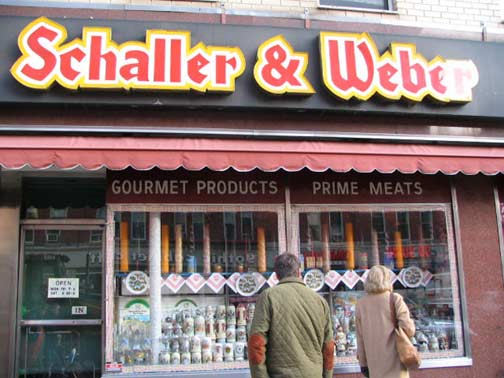Your webmaster and ForgottenFan Vicki went for a walk in the east 80s looking for traces of Yorkville the other day. The neighborhood, concentrated from about East 78th to 90th between 3rd Avenue and the East River, used to be NYC’s largest bastion of German immigrants, who flooded the region and in fact, in the mid-20th century, the only metropolitan area in the world that could muster more Germans was Berlin itself.
Yorkville did not start out as a German neighborhood; from colonial times, it was a small settlement on the Upper East Side clustered along the now-disappeared Boston Post Road as it meandered north.
Beginning around 1930 German as well as eastern European and Irish immigrants began moving to the East 80s. There were greater opportunities to find work as well as new apartment buildings began to appear at the time, and there was plenty of mas transportation. Bear in mind that NYC had many trolley car lines and both the 2nd and 3rd Avenue Els were in business until 1940 and 1955 respectively. But the neighborhoods around the els began to dilapidate and age, and calls rang out to eliminate the els and let the sunshine in.
Coincident to the departure of the els came the departure of the neighborhood’s ethnic flavor.
Social clubs and religious and educational institutions sprang up in Yorkville, creating and maintaining a network where German traditions were practiced and celebrated. Similarly, German restaurants, stores, beer halls, bookstores, and music venues guaranteed that German residents felt right at home and outsiders and visitors felt immersed in German culture. Eighty-sixth Street was considered German Broadway where one could purchase, consume, and enjoy all things German.
Since the 1960s however, almost all of these German staples have disappeared, leaving little trace of the German culture that once defined the area. Post–World War II real estate development initiated a gentrification process that included soaring rents and often unwelcome high-rise buildings. A new and wealthier demographic meant that German businesses were forced to close…Immigrant Heritage Trail
Schaller and Weber, established in 1937 just as thousands of Germans and eastern Europeans moved into Yorkville, remains the foremost representative of the neighborhood’s former identity. Brand names that I remember from the German butchers in the Bay Ridge of your webmaster’s youth are stil here: Knorr, Maggi, Panni, Bechtle. I’ve always been fond of the German predilection for meals of meat, potatoes and vegetables, and German cuisine is unafraid of carbs (a meat & potatoes diet served my father well for 84 years). (Sauerkraut, however, is still problematical for me.) I’ll eat anything ending in -schweiger, -braten or-schnitzel.
Located at 1654 2nd Avenue on the SE corner of East 86th, the boxed candy, decorative steins, and sausages are displayed prominently. In season, S&W can obtain pretty much any kind of game meat you could ask for. They continue the tradition of a free slice of baloney for every kid who comes in.
 Next door we find Heidelberg, one of the last restaurants in the area offering pure German fare (though there are still a number in Glendale, Queens, and there’s Killmeyer’s Old Bavaria Inn in Charleston, Staten Island, a Forgotten favorite).
Next door we find Heidelberg, one of the last restaurants in the area offering pure German fare (though there are still a number in Glendale, Queens, and there’s Killmeyer’s Old Bavaria Inn in Charleston, Staten Island, a Forgotten favorite).
If it’s boiled pig knuckles you’re looking for (a wee adventurous for your webmaster) or something I’m fonder of, the jaeger schnitzel, breaded veal smothered with a mushroom-cream gravy, served with spaetzle and red cabbage, Heidelberg is the place. Here’s a customer review from menupages.com:
A place that apparently hasn’t changed in years and that’s a good thing. Waitresses in peasant dresses and waiters in lederhosen – even our Latino waiter! Great food. The great potato salad was light without mayo and very light in vinegar. The red cabbage not so sour – the best I’ve had. A potato pancake of shredded potatoes was light, almost fluffy – deep fried to a crisp brown but without grease! The pot roast was flavorful and tender. The “beer garten” has no vegetation but it was delightful to be outside and in a quiet space in the middle of the city. It’s at the back of the building next to the kitchen and a ventallation fan blows the cooking smells into this area — good smells and not disturbing.
Looking for even more German ambience? There’s the Liederkranz, which continues German musical and vocal tradition with concerts and events at 6 East 87th Street just off 5th Avenue and Central Park.
2/4/08







1 comment
I was also under the impression that the General Slocum disaster decimated the population of the German East Village, killing mostly women & children, so many of the remaining men found it too painful to remain there, and moved north to Yorkville… at least that’s what NYC history prof & tour guide ‘par excellance’ Joyce Gold told me once on one of her tours… (She has great history tours of various NYC neighborhoods… but I suspect you must know of her.)
Comments are closed.